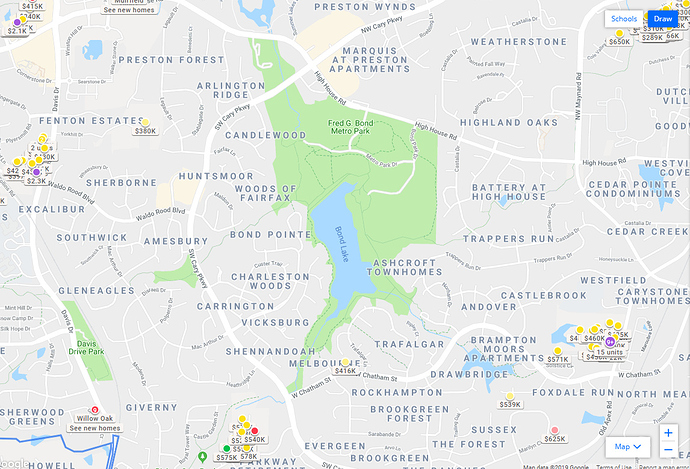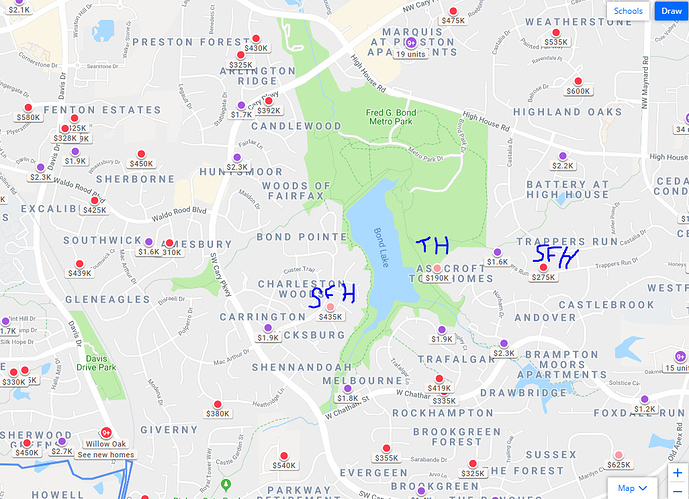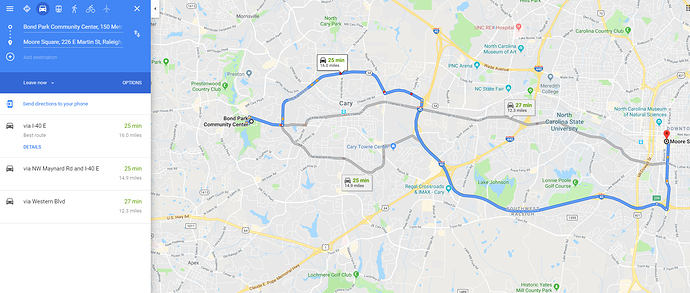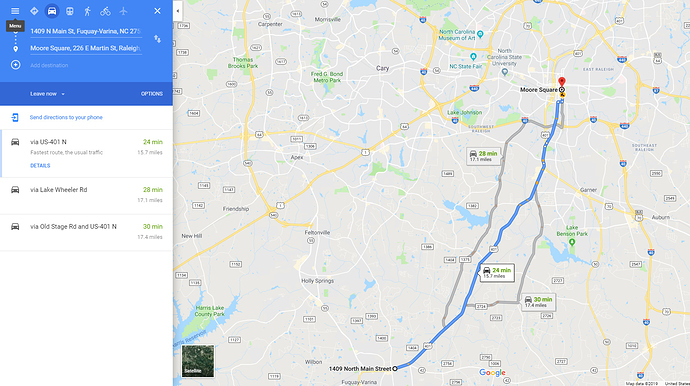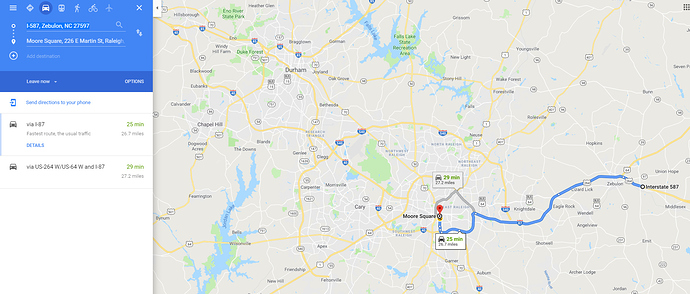I was thinking more about allowing duplexes in my neighborhood and I was thinking that it would actually not help the poor (or less well off). My house is a 1250 square foot ranch which is located near Bond Park in Cary. By Cary standards our neighborhood has small homes and are a bit more affordable. If homes were torn down in my neighborhood I guarantee you that they would be replaced with duplexes that each would probably sell for well over $300,000 each. So the net result would definitely be more density, but I think the smaller more affordable homes in Cary would eventually be replaced by larger more expensive duplex homes.
I agree completely. If someone buys a house in most single family neighborhoods and puts up a duplex, they’re doing it to maximize profit from that lot. The duplexes would be geared to people who could afford that neighborhood anyway, but want less property to deal with, or believe that people in cities should live on a smaller footprint.
The gentrification is going to happen there no matter what. This whole discussion is really a question of if additional density should be encouraged along with the gentrification. I think the additional density would be a good thing.
If you look at the Bond Lake area (I am extremely unfamiliar because it is way on the west of Cary. The development is pretty interesting going on there. Here is a map of what has been built since 2010
Pretty much nothing around the lake. but then new homes getting squeezed into new subdivisions where there is still open land. New homes from the high $300 anywhere up to the $600,000. Seems like SFH’s are not having a problem being built, but there are also some townhomes in there under $200,000. My guess is that you could legalize (who knows what the current zoning is anyway maybe they are?) duplexes all over this area and maybe 2 would get built a year. There is so much money to be made on big SFHs that this is what will be the majority of what gets built. Here is what is just for sale now regardless of when it was built.Older town-home for under $200,000 it interesting.This forum is about DTR, so I think it is good to point out that Bond Lake is 25min by car from DTR.
The almost gets you to Downtown Fuquay or or Rolesville, or past Zebulon.There are multiple issues at hand here.
- replacing 1 SFH with 2 duplexes, although perhaps more expensive, relieves some of the disparity between supply and demand at least within that neighborhood, possibly preventing a bidding war on another property.
- the tax base per linear foot of infrastructure metric is greatly improved
- 2 families can now occupy the space where one was previously, allowing our area to grow without destroying virgin forest.
Multiply these effects across a whole city of SFHs (80%+ in Raleigh) and you get drastic improvements in these areas. Of course traffic and “character” are separate issues, solved by transit and changed attitudes.
The majority of this board is likely down with the benefits.
That’s a really good point, honestly. I guess there’s not much to be gained (at least in the next few years) with respect to affordable housing and transit-oriented development by having more duplexes and other types of missing-middle housing. …at least, until we have a good example we can point to.
True, good point. Just allowing duplexes will open up a new market for developers, renters etc., but I guess you can’t just expect the market to shift towards helping out lower-income families (and, if anything, it’ll probably give more options to people on the other side of the wealth spectrum)
In light of the points @TedF and @John mentioned, what if we don’t immediately apply this to the whole city… but at least, start off by encouraging duplexes and other missing-middle housing in overlay districts? Making it so that new single-family homes cannot be built inside the Beltline if you’re within 500ft of a planned BRT station, for example.
Very well said. I agree with this. I’m not sure the whole city would need to be rezoned to allow this but perhaps areas adjacent to Transit-Oriented Development (TOD) zones would make sense. Sticking with @TedF’s neighborhood as an example, Cary might have to find other areas to allow it before the Bond Lake area, I think.
And borders probably don’t matter. If Raleigh allows more that takes pressure off the suburbs to a certain degree. We’re all connected, I believe that relationship exists.
What we need though are for SFH neighborhood supporters to show up in favor for density in areas zoned exactly for that. I figure when folks living in North Raleigh being against towers in downtown don’t understand, or just don’t believe in, that relationship I mentioned.
The controversy becomes when, as the city grows, we need current SFH neighborhoods that were once the suburbs in the 1950s but are now “in the city” to become upzoned.
Leo, do you think this title should be “…/Suburban Sprawl”, ?. The whole idea of urban is to reduce sprawl and suburban is the definition of sprawl. I think the term ‘urban sprawl’ is any oxymoron and lends a negative connotation to attempts to properly urbanize areas.
I feel the same way about the term Urban Sprawl. It is generally used as a “look over there!” to either not look at or distract from straight up sprawl.
Which lets all be very honest. There is maybe 50 times the suburban sprawl as there is any type of urban creep.
From my perspective, I’ve heard it used interchangeably. All these articles saying, “People are moving to cities” what they mean is they are moving from rural areas to the suburbs/city. North Raleigh, to me, is still “in the city” but it’s urban sprawl.
Short answer, not too worried about the title. 
I’m with you for how SFH residents need to support dense developments (or at least learn to be that way), but… this sounds to me like it’ll have at least one of these problems:
- only a very small slice of people actually support this
- only a very small slice of people care enough to have such a nuanced conversation
- the re-definition problem you mentioned at the end
I feel like you could tackle the last issue by baking in a method to use land value thresholds or traffic/transit patterns to automatically up-zone someplace without forcing a controversial, probably-misinformed discussion to happen every single time. But I guess finding the right metric could be nasty in its own right, too.
As for the first two… how would you engage residents in the suburbs for things like this, though? If you think about the average sort of person living there (or how they vote), they’re not exactly the best-connected or best-engaged people of all time…
Ok I hear you. But the difference between jammed up poorly planned areas and areas that are well planned with enough transit, street connectivity, sidewalks, mixed used buildings and mixed use sites is stark. One requires complete car dependence. The other allows or even urges the non ownership of a car. Like ADUs says, there is sneaky ‘look over there’ wrapped up in the term. You’re actually proving my point when you say you’ve heard it used interchangeably and now you are doing so too. I’m sticking to my guns and think you should too and make clear the distinctions here. They are fundamental to many of the arguments we discuss here and underly the reasons why there is support for specific projects and such here.
Just my two cents… The “American Dream” equals home ownership, which has been perverted into meaning SFHs. When the vets came back from WWII, the government perpetuated the suburbanization of the country to the point it became the “norm” for for most folks to own their own pied de terre. Three generations later, that is what is “expected” to show that you are a successful member of society. When I bucked the system and bought a townhouse (OMG, I am attached to 3 other folks!!) my parents back home thought I had completely lost my mind. I guarantee they will never mention to any of their friends that their son bought a “townhouse”. Those are for retirees, not families and professionals. When I mention being able to walk to 2 grocery stores, a dozen restaurants, and tons of shops, the response is “Son, you have a car, right?” (I can’t make this stuff up)
My point is, we need to change the way society views density as being a negative thing. I would make the same choice over and over again to be able to live in such a walkable area (even if it is in suburbia). We couldn’t be happier in our home. And all the things I was told “you have to have” (IE a yard and a garage) is all BS. My kids ride their bikes and roller skate in the street nearly every day, and have the time of their lives doing it.
Rather than prohibiting single family homes, I’d suggest that they remove any density related restrictions on residential development within 500’ of a BRT corridor. If someone has the money and wants a single family house they should still be able to build it. But if someone wants to redevelop a single family lot as 3 Townhomes they should be allowed to. If they want to assemble 4 single family lots and build a 4 story condo building within 500’ of a BRT corridor, they should be allowed to do that as well. I think this would lead to density without the need of any prohibitions.
Just to start with I would remove those residential density restrictions and allow the market to provide density where transportation options are available.
The non-residential areas have already been established by the plans, and I think those are generally fine. If more are needed, they can be handled by comp plan changes and rezonings.
I think that there would be little resistance to a different zoning model within a certain amount of distance from a proposed transit stop or major roads. As it stands now, there is already a mix of housing types in the more urban neighborhoods of the city.
The duplex I once lived in was on Arlington St., adjacent to some of the most expensive ITB SFHs in the city (Hayes Barton). It wasn’t a big deal. There are also transitions to some other higher dollar neighborhoods in the city where they meet major roads. North Ridge is a good example of this. Off of Hunting Ridge, Spring Forest, and Harps Mill Roads are a combination of apartments, duplexes and affordable townhouses that buffer the SFHs from the main roads. Again, it’s no big deal.
There’s nuance to this issue though, as I don’t think plopping down multifamily housing of any type in the middle of single family homes is going to solve for anything and only make the neighbors cranky and politically resistant. A battle could be won and the war would be lost.
I think that we need to follow common sense here and place higher density along corridors where it makes sense, and in districts that are (or can be) rapidly densifying. It needs to be supported by, or in support of transit options we have to today or are planning for the future. We must avoid decisions that make it appear to be a punishment to “those evil people in single family houses”, because if it’s perceived that way, we will have a war that we can’t statistically win in a city with such a high volume of single family homes.
SJ and Raleigh have similar problems… and our city council needs to learn sooner than later
Its important to realize (as you allude to with the post) that being poor is exacerbated by the fact that poorer people are being pushed to areas with little to no public transportation. Buses rarely go to Garner or Fuquay. East Raleigh used to be tenable because you could at least walk to the bus station. Walk to downtown’s stores and such. Now, look around say Mini City. People are walking in all sorts of unsafe places. They are reliant on the #1 bus primarily. As transit is rightly directing focus to managing urban growth, it is at the expense of not serving the 'burbs…where many of the poor end up. They, then need a car, making being poor much less tenable than it used to be. The two prong approach would be…1)allowing less crap development (making survival without the expense of a car possible to reduce cost of living), and 2)if you are going to allow crap development (single use everything), at least mandate sidewalks on every foot of curbed street and quadruple bus service to those single use areas so they are less crappy/a little more tenable without a car.
I’m not completely sure that this is the best thread for this article but I think it exemplifies the kind of knee-jerk response people are having to urban density in their neighborhood… As a white male baby boomer I must say that I am embarrassed for my cohort after reading this. People with privilege showing up at City Council meetings to shout down those who support helping the homeless, building bike Lanes, bus Rapid Transit routes and other things meant to mitigate these very problems. The positive side of the article describes what some cities are doing to restructure how they get citizen feedback. Just because people shout the loudest doesn’t mean they are in the majority.
I read that this morning too, but don’t see any real evidence that these are progressive people shouting down these meetings. Certainly there are more progressive areas than others, but that doesn’t mean that everyone there is progressive. There are plenty of bitter, older, conservative white people in these progressive towns that will let their voices be heard. They may also be some hypocritical progressives in their ranks, and shame on them. Shame on all of them. As white, male, (barely) Boomer, I call out my demographic cohort.
What we learn about them from the article is that they are primarily older and primarily white. We also know that they have a place of status in society. FWIW, I am trying not to use the work privilege as much because it’s become so toxic that you can’t have a discussion anymore with anyone without it triggering and sending the conversation about a topic into a completely different direction.
